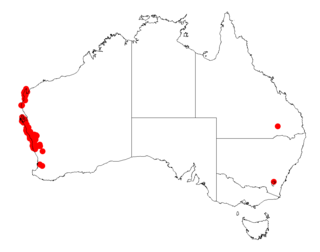
Acacia flexifolia, commonly known as bent-leaf wattle or small winter wattle, is a shrub species that is endemic to eastern Australia.

Acacia adoxa, commonly known as the grey-whorled wattle, is a species of flowering plant in the family Fabaceae and is endemic to north-western Australia. It is a dense, low-lying shrub with linear, more or less cylindrical phyllodes in whorls of 6 to 10, heads of golden-yellow flowers, and flat, sticky pods.

Acacia conjunctifolia is a shrub belonging to the genus Acacia and the subgenus Juliflorae. It is native to parts of northern Australia.

Acacia gonoclada, also known as ganambureng, is a tree or shrub belonging to the genus Acacia and the subgenus Juliflorae that is endemic to northern Australia.

Acacia leptophleba is a shrub belonging to the genus Acacia and the subgenus Juliflorae that is endemic to northern Australia.

Acacia oncinocarpa is a shrub or tree belonging to the genus Acacia and the subgenus Juliflorae that is endemic to northern Australia.

Acacia tetraneura is a shrub belonging to the genus Acacia and the subgenus Juliflorae that is endemic to western Australia.

Acacia thomsonii, commonly known as Thomson's wattle, is a shrub or tree belonging to the genus Acacia and the subgenus Juliflorae that native to parts of northern Australia.

Acacia errabunda is a shrub belonging to the genus Acacia and the subgenus Phyllodineae native to Western Australia.

Acacia mutabilis is a shrub belonging to the genus Acacia and the subgenus Phyllodineae that is endemic to south western Australia.

Acacia profusa is a shrub of the genus Acacia and the subgenus Phyllodineae that is endemic to south western Australia.

Acacia spathulifolia commonly known as Gold carpet or the Gold carpet wattle is a shrub of the genus Acacia and the subgenus Phyllodineae that is endemic to coastal parts of western Australia.

Acacia ascendens is a shrub of the genus Acacia and the subgenus Plurinerves that is endemic to a small area in south western Australia.

Acacia oswaldii, commonly known as boree, umbrella wattle, umbrella bush, whyacka, middia, miljee, nelia and curly yarran, is a shrub or tree of the genus Acacia and the subgenus Plurinerves.
Acacia pelophila is a shrub of the genus Acacia and the subgenus Plurinerves that is endemic to a small area along the west coast of western Australia.

Acacia tetanophylla is a shrub of the genus Acacia and the subgenus Plurinerves that is endemic to an area of south western Australia.

Acacia undosa is a shrub of the genus Acacia and the subgenus Plurinerves that is endemic to an area of south western Australia.

Acacia vittata, commonly known as Lake Logue wattle, is a shrub of the genus Acacia and the subgenus Plurinerves that is endemic to a small area in western Australia.

Acacia warramaba is a shrub of the genus Acacia and the subgenus Plurinerves that is endemic to an area of south western Australia.
Acacia polyadenia is a shrub or small tree belonging to the genus Acacia and the subgenus Juliflorae that is native to north eastern Australia.



















